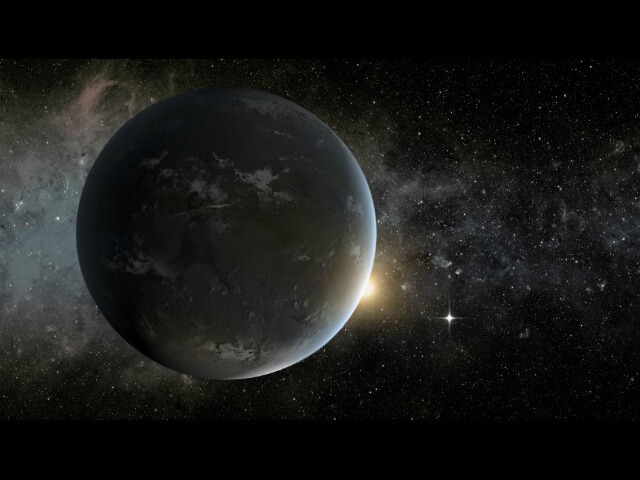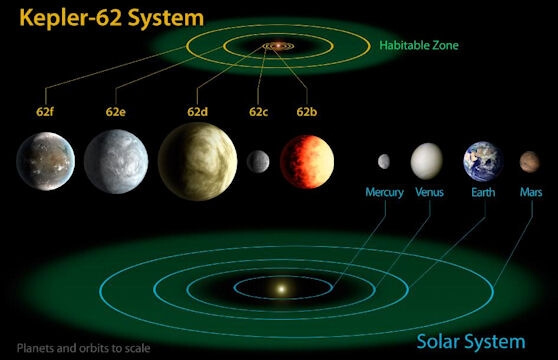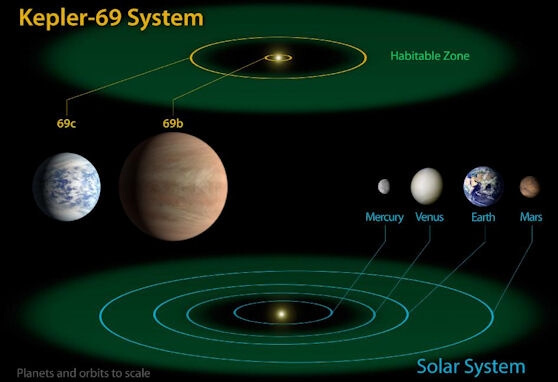Scientists have discovered three planets that may have liquid water on their surfaces

In recent years, astrophysicists have discovered about 800 planets in other solar systems, but the vast majority of them are not suitable for sustaining life similar to ours. Most of them are much larger than the Earth, and mainly very close to their sun, or very far from it, and the temperature on their surface does not allow the presence of liquid water, which is considered a condition for the existence of life - at least in the form we are familiar with. Two new findings of the "Kepler" space telescope published today, break this limit with the discoveries of three planets that are located in the region of two suns, i.e. at a distance from them that allows the presence of liquid water. Two of the planets orbit a sun known as "Kepler 62" and one around "Kepler 69". They are only slightly larger than the Earth and the researchers believe that it is definitely possible that there are oceans on their surface.
"The three planets that NASA announced today are the closest thing we know of today to the habitats of life as we know it, but we're not there yet," says Dr. Avi Shapoer from the University of California, the partner in the discovery of the Kepler 62 planets. "In a broader view, we can say that these discoveries are a very important milestone on the way to the discovery of planets that are exactly like Earth, and this is going to happen in the very near future, with Kepler."
stars outside
The "Kepler" space telescope, which was launched about four years ago, detects distant planets by measuring the tiny decrease in the light intensity of their sun, when they pass by it. After the first identification of a Sun that is a candidate for such planets, astronomers focus on it with additional observations, and try to locate more such "defects". Their precise measurements make it possible to determine the speed of the planet and its distance from its sun, and to estimate its size and the temperature on its surface. The sophisticated measurements may also reveal multi-planet suns (like our Sun, which has eight and a few other fairly large celestial bodies that defy definition). "Kepler 62" is surrounded by no less than five planets, as the researchers report today in the journal Science. The two furthest away are the ones that are apparently in the "area of the yeshiva". "Kepler 69", whose report is published in the Astrophysical Journal, has two planets, one of them in the range suitable for the existence of liquid water. By the way, the "Kepler" telescope was supposed to end its mission this year, but in light of its success (so far 122 new planets have been identified with its help), NASA decided to continue operating it until 2016.
long way
Before we pack our swimsuits for swimming in the oceans of these planets, it's worth paying attention to the issue of distance. "Kepler 69" resides no less than 2700 light years from us, "Kepler 62" - "only" 1200 light years. Even if there is life there, we have no practical possibility to communicate with them. The researchers believe that the discovery of planets very similar to Earth is only a matter of time, and say that if the three discovered now exist, there is no doubt that there are many more.



7 תגובות
I disagree, father. Right now the main interest in space is perhaps for military passengers, scientific research, communication satellites and a number of bored millionaires, but eventually a private market will be found for space travel, otherwise they simply won't happen.
By the way, one of the worst things that happened in space exploration, was stopping the militarization of space. Note that this went hand in hand with investing huge budgets in space. With all due respect to pacifism and the love of man, in the end scientific research in the last 500 years was preceded by virtue and mainly because of military-political interests. Only then will they find use in the private market. There is no reason to think that space exploration will be any different.
Another one, sorry for the delay, but the rejoicing in England at the death of Margaret Thatcher shows that your arguments against the role of governments are incorrect. We saw that as a result of this policy, which only cares about the immediate, we lose progress in the long term. Someone needs to think about the long term, the economic models you believe in are the main obstacle.
The private market was perhaps relevant in the 19th century and much of the 20th century. Today, a lot of money is required for great science - large space telescopes, particle accelerators, advanced biological equipment. A few donors (those tycoons who drank all of our money) can afford it, but even then many of them don't because they failed science in high school, and prefer to finance vanity, buy politicians who will deny global warming and build unnecessary giant buildings.
Indeed, David is right, and as I wrote here in a comment a few weeks ago on a similar topic - in fact it is also possible to include our moon and the 2 moons of Mars. All these bodies - Venus, Mars, the various moons (ours and Mars) - are all in the "seat" area, but only the Earth is suitable for life as we know it, and the reasons for this are many and varied.
In fact, statistically, it can be argued according to the statistics that we see here, that only about 15% of the objects in the Yeshiv region are life-supporting (that is, the planets and moons that exist there), and this is only based on our solar system, where almost all objects in the Yeshiv region have the same mass (The differences between Venus, Mars, the Earth and the Moon are very small, relative to the possibility that it is super-like with a mass 5 times greater than the Earth).
It's actually very hard to tell.
Until it is definitively disproved that there is no life on Mars / it never developed, and until the theory about life in the upper atmosphere of Venus is not disproved (such similar life was discovered at an altitude of 40 km above sea level here), it will be impossible to truly know whether the existence of the planet in the region The answer guarantees the existence of any kind of life, or it is not mandatory at all (for example, it is possible that we will discover life in Europe, and then our model of where life exists will change completely).
This discovery does not mean that there are Earth-like stars there - it is not enough that a planet is in the zone of life, see for example Mars and Venus - both as planets in the zone of habitation but without life and without a life-supporting environment as we know it.
It is generally best to keep fame-hungry politicians out of academic research.
For scientists to think for themselves what is most important for the advancement of science and why there might be a possible practical use in the future and then look for private investors or donors - the heroic space age has long since ended and it's a good thing.
Yaron
what are you trying to say Aren't we living in the sixties?
But why is there no Mars mission project? This requires much less advanced technology than 2700 light years.
Lately Nasa has been playing Kailu. They are not a space organization for anything anymore.
And why don't the countries of the world unite in the absence of the USA as the leader of space - as it was in Kennedy's days.
During the Obama era, Nasa was dismantled. I understand that if there is no money in the cash register there is no money for Mars. But Kennedy knew how to make the business profitable.
Through the commercialization of the technologies developed for the space industry. I will give a simple example from us. In the past GPS navigation was a military and passenger aircraft technology. Today everyone in the West has a smartphone with GPS and Wiz. I know about the commercialization and privatization of the space program, but so far we hear bombastic news about nothing. Virgin's space plane does not leave Earth, development of US launchers for satellites. The Russians have had it since 1954. This is backwardness.